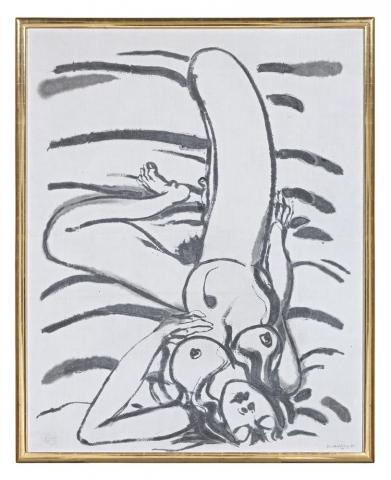NUDE, BALI, 1980
BRETT WHITELEY
ink on cotton
172.0 x 137.0 cm
signed and dated lower right: Brett Whiteley 80 / Bali
Estate of the artist, Sydney
Australian Galleries, Sydney
Savill Galleries, Sydney
Private collection, Sydney
Brett Whiteley: Recent Nudes, Artist’s Studio, Circular Quay, Sydney, 3 – 31 October 1981, cat. 59, as Nude in Bali, ink on hotel sheet
Brett Whiteley Drawings, Australian Galleries, Sydney, 16 September – 15 October 1994, cat. 24, as Bali (Wendy on a Sheet), 1980
For Whiteley, a deep appreciation for the sensuality of the human form permeated every aspect of his life and art. Recognised by art critic Bryan Robertson during Whiteley’s early years in London as ‘a level of sexual and sensual sophistication rare in an artist so young’1, indeed this predisposition would ultimately underpin and inspire his entire creative oeuvre. Without doubt however, it is in the myriad of paintings, drawings, sculptures and etchings dedicated to the female nude that Whiteley most thoroughly and adeptly manifests his abiding preoccupation with the sensual and tactile – exploiting the expressive and abstract possibilities of the genre to create some of the most erotic nudes ever conceived by an Australian artist. Clearly, Whiteley also considered the subject ‘predominant really…a very major part of my work’2, elaborating thus ‘…If genius is the atheist’s word for God… then the attempt to visualise the great nude would be the highest point of creation, for perfection is impossible, and no distortion can be extreme enough.’3
Exemplifying this sheer delight in the beauty of the female form, Nude, Bali, 1980 was executed during the artist’s trip to Bali in 1980 with his closest friend, sculptor Joel Elenberg who, dying from cancer, had decided to spend his final weeks in the island paradise. Although an emotionally turbulent time for Whiteley during which he endured a protracted period of mourning – as poignantly attested by works such as The Letter (To Anna), 1980 – 81 – there is notably no hint of sadness in his interpretation here. Rather, evoking parallels with the reclining odalisques of artistic predecessors including Matisse and Gauguin, the painting exudes a sense of languid, sensual pleasure. Moreover, with the figure here dominating the picture plane, the composition also echoes Whiteley’s own earlier ‘Bathroom series’ – his first consolidated depictions of the nude which celebrated his love for his new wife and muse, Wendy, and heralded his breakthrough as an accomplished figure draughtsman.
Two decades later, however, the erotic is made arguably more explicit in the model’s provocative frontality – she is voluptuous, fecund and overtly sexual. Infused with an unmistakable sense of voyeurism, the work is a superb example of Whiteley’s lifelong quest to visualise the ‘perfect’ nude; as the artist himself wrote with characteristic irreverence in catalogue notes accompanying an exhibition of comparable nudes in 1981,
‘…most men, and certainly all artists, even if many never get around to actually painting it, carry in their heads the great nude. The Venus, the Bathsheba, the Bather, Diana, even the great centrefold, he carries all his life the idealisation, carries it like some little uncut gem in his mind, waiting there to be given form. Filtering down through civilisation is the urge to show this glimpse of beauty, where invention and skin become one, and the history of art marries the whole history of one’s sex. Mistress, mother, lover, whore, obtainable – unobtainable, it is the wonder of a perfect distortion.’4
1. Robertson, B., cited in McKenzie, J., ‘Obituary: Brett Whiteley’, ‘Divided Self, Sweeping Line’, The Guardian, 18 June 1992, n.p.
2. Whiteley, B., cited in Don Featherstone's film Difficult Pleasure: A Portrait of Brett Whiteley, 1989.
3. Whiteley, B., ‘Recent Nudes’, exhibition catalogue, Artist’s Studio, Sydney, 1981, n.p.
4. Whiteley, B., ibid.
VERONICA ANGELATOS
